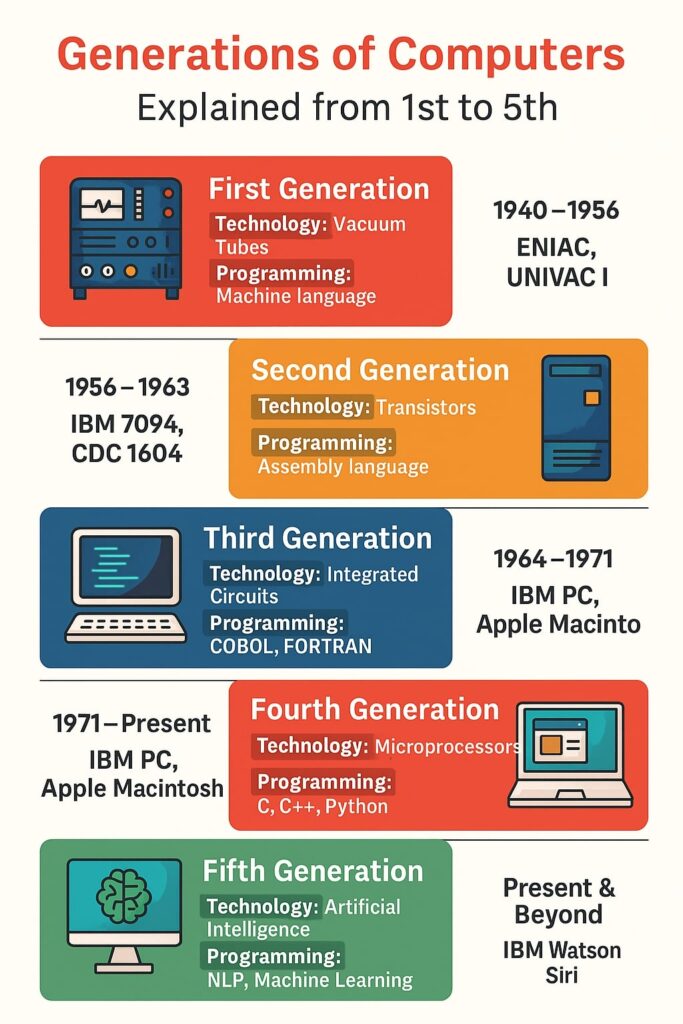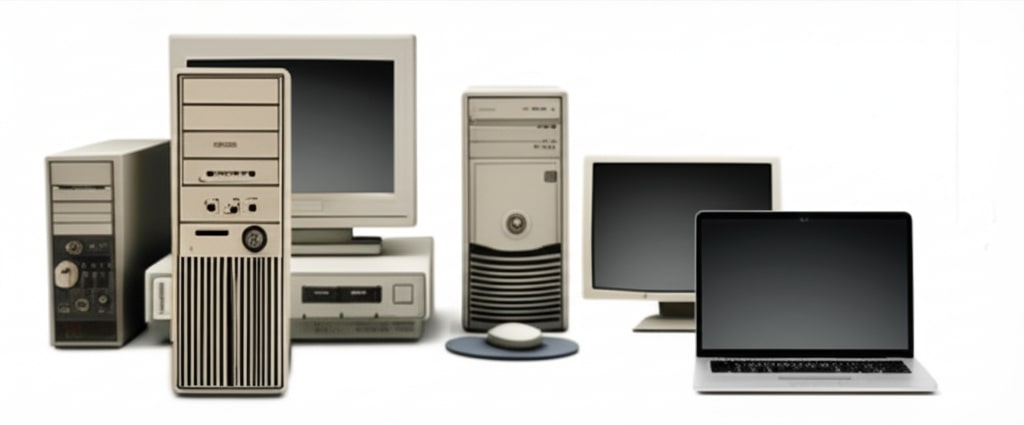Computers have undergone a fascinating journey from room-sized machines to the ultra-fast, AI-powered systems we use today. This evolution is classified into five generations of computers, each marked by significant technological advancements.
Let’s explore all five generations of computers, their technologies, characteristics, and real-world examples.
What Are Generations of Computers?
The term “Generations of Computers” refers to the chronological stages in the development of computer technology. Each generation represents a major shift in hardware, programming languages, speed, efficiency, and user interaction.

Generation of Computer 1st to 5th
1st Generation Computers (1940–1956): The Vacuum Tube Era
🔧 Technology: Vacuum Tubes
💾 Programming: Machine Language
📏 Size: Room-sized machines
⚡ Speed: Very slow
First-generation computers used vacuum tubes to perform calculations. These machines were massive, expensive, and consumed enormous electricity. They could solve only one problem at a time and required extensive maintenance.
🖥️ Examples:
- ENIAC (Electronic Numerical Integrator and Computer)
- UNIVAC I (Universal Automatic Computer)
✅ Advantages:
- Pioneered electronic computing
- Used in military and scientific research
❌ Disadvantages:
- Overheated easily
- Required constant supervision
- Extremely slow and large
2nd Generation Computers (1956–1963): Rise of Transistors
🔧 Technology: Transistors
💾 Programming: Assembly Language
📏 Size: Smaller than first-gen
⚡ Speed: Faster and more reliable
The second generation replaced vacuum tubes with transistors, making computers faster, more compact, and energy-efficient. They introduced magnetic core memory and allowed batch processing.
🖥️ Examples:
- IBM 7094
- CDC 1604
✅ Advantages:
- Smaller and faster
- Consumed less power
- Easier to program
❌ Disadvantages:
- Still generated heat
- Maintenance was required
3rd Generation Computers (1964–1971): Integrated Circuits
🔧 Technology: Integrated Circuits (ICs)
💾 Programming: High-level languages (e.g., COBOL, FORTRAN)
📏 Size: Much smaller
⚡ Speed: Significantly improved
Third-generation computers used ICs, which allowed dozens of transistors to fit onto a single chip. These computers were cheaper, more efficient, and allowed multi-tasking and time-sharing systems.
🖥️ Examples:
- IBM System/360
- PDP-8 (by DEC)
✅ Advantages:
- Compact and reliable
- Lower cost and energy usage
- Supported more programming languages
❌ Disadvantages:
- IC manufacturing was complex
- Still not user-friendly for the public
4th Generation Computers (1971–Present): The Microprocessor Revolution
🔧 Technology: Microprocessors
💾 Programming: Advanced high-level languages (C, C++, Python, etc.)
📏 Size: Desktop and portable
⚡ Speed: Millions of instructions per second
Fourth-generation computers introduced microprocessors, allowing entire CPUs to fit on a single chip. This era saw the rise of personal computers, graphical user interfaces (GUI), and networked computing.
🖥️ Examples:
- Intel 4004 (first microprocessor)
- IBM PC
- Apple Macintosh
✅ Advantages:
- Affordable and accessible
- Increased storage and processing power
- Support for modern software and internet
❌ Disadvantages:
- Vulnerable to cyberattacks
- Environmental concerns due to e-waste
5th Generation Computers (Present and Beyond): The Age of AI
🔧 Technology: Artificial Intelligence, Quantum Computing (experimental)
💾 Programming: Natural Language Processing, Machine Learning
📏 Size: Compact, cloud-based, and scalable
⚡ Speed: Real-time, AI-driven responses
Fifth-generation computers aim to create machines that can think and learn like humans. They use AI algorithms, big data, and quantum logic (in R&D) to enable natural interactions and decision-making.
🖥️ Examples:
- IBM Watson
- Google Assistant, Siri
- Quantum computers (by Google, IBM, etc.)
✅ Advantages:
- Intelligent decision-making
- Real-time language and facial recognition
- Automation and robotics
❌ Disadvantages:
- Ethical concerns with AI
- High development cost
Comparison Table: Generations of Computers
| Generation | Years | Technology | Programming Language | Example |
|---|---|---|---|---|
| 1st | 1940–1956 | Vacuum Tubes | Machine Language | ENIAC, UNIVAC |
| 2nd | 1956–1963 | Transistors | Assembly Language | IBM 7094 |
| 3rd | 1964–1971 | Integrated Circuits | COBOL, FORTRAN | IBM 360, PDP-8 |
| 4th | 1971–Present | Microprocessors | C, C++, Python | IBM PC, Apple |
| 5th | Present+ | AI, Quantum | NLP, Machine Learning | IBM Watson, Siri |
Conclusion
From vacuum tubes to AI-powered machines, the five generations of computers reflect how rapidly technology has transformed. Each stage brought innovations that reshaped not just computing, but society itself.
As we move deeper into the age of artificial intelligence and quantum computing, the future of computing promises to be even more exciting — with endless possibilities.
FAQ
First-generation computers used vacuum tubes and machine language, while fifth-generation computers use AI and natural language processing.
The IBM System/360 and PDP-8 are prominent examples.
Yes, most of today’s personal computers are 4th generation, though AI integration marks the shift toward the 5th generation.
Read more blog on Ezine Articles
